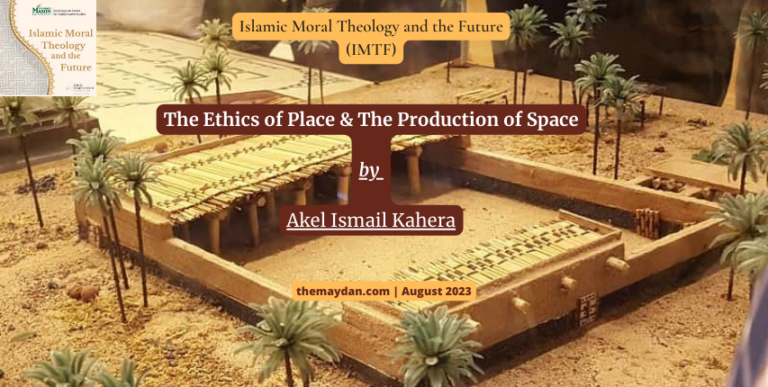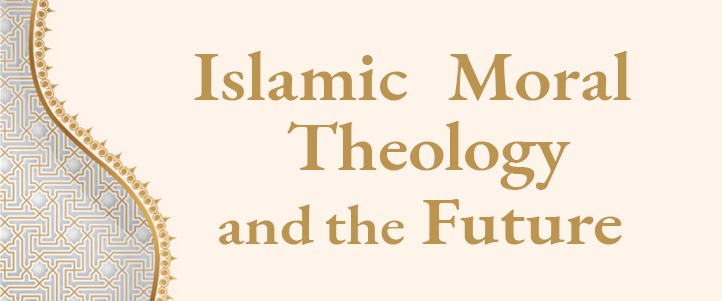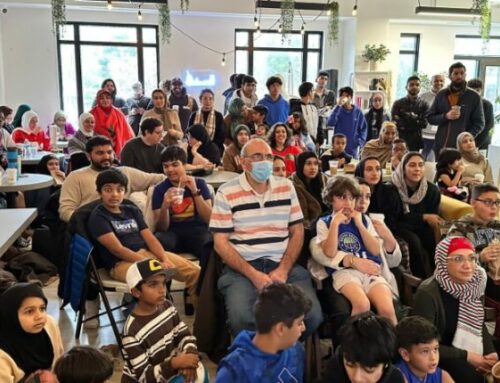
The Ethics of Place & The Production of Space
My task here is to offer some critical thoughts on the ethics of place and the production of space, with the ‘American mosque’ as a case in point. I have argued in Deconstructing the American Mosque: Space, Gender, and Aesthetics (2002), that the religious and spatial needs of American Muslim women and men is a complex configuration of transcultural modalities of place (including both rural and urban sites) and architectural space, that have converged to inform the putative concept of the ‘American Mosque.’ In terms of transcultural modalities, it is easy to see why Lefebvre upholds the idea that space is constructed socially, and at the same time relies on a set of human relations. Professor Dakake’s question emphasizes this issue: “How can or should contemporary mosques honor both the legacy of the Prophet’s original mosque, and the contemporary spiritual and social needs of Muslim women in the public sphere, by building mosques and creating mosque cultures in which the space is equally available to men and women?” In short, the ethics of place are not shaped by religious ideologies alone, biopolitics is at play, and as Foucault has claimed, it involves the right “to ensure, sustain, and multiply life, to put this life in order.”
First, we need to define the ethics of place as it relates to the American Muslim community. The ethics of public places involves giving back to the community and respecting the needs and rights of others. This also means abstaining from actions, behaviors and practices that negatively impact others, showing consideration for other’s needs, and engaging in activities that strengthen the community. Thus, the ethics of place is a catalyst to heighten moral behavior and at the same time it encourages communal consciousness in ‘quotidian life.’ One possibility for defining the ethics of place as it pertains to the American mosque resides in the knowledge that is inextricably tied to the behavior and mannerisms within the context of Islam’s original mosque (masjid)——the Prophet’s Mosque that was built in the city of Madina, Arabia, in the year 622 CE. Hence, it could be argued that a primary definition of the ethics of place resides in the textual account of the original masjid, which is the mosque in the time and place of the Prophet. That masjid proved acceptable as a precedent, given the importance of the Prophet’s sunna (practice, tradition, and quotidian ethics) in general. In other words, we can develop a paradigm for a ‘spatial sunna’ based on the ethics and behavior manifested in the Prophet’s Mosque. Examining the ethics and ideals of behavior in this mosque, as reported in the Qur’an and ḥadīth, helps us to readily recognize the essential function of a masjid, and the ideals of operative propriety in the mosque space. For example, the fact that statuettes and other forms of imagery, human or animal, are not found in a masjid, would suggest that the Muslim community is fully aware of the Qur’anic injunction: “The places of worship (masājid) are only for Allah” (Qur’an 72:18), and the application of this principle to the mosque environment.
Interestingly, however, this way of thinking about the production of space presents a further concern about an environment that is far from neutral. The masjid was described as a “house” (for the Prophet and his family) by a handful of historians but this contention has been vigorously disputed by others leading to questions regarding the extent to which the edifice should serve as a model for later mosques that do not function in this same and irreplicable way. The building’s orientation to Makkah (qibla), however, is a clear indication of its ontological axis (qibla) and the later the addition of the mihrab is evidence that its primary function was that of a place of worship.
The motivation behind the novel configuration of the Prophet’s mosque serving as the original, and therefore, ‘seminal’ masjid, based on its description in textual accounts (aḥādīth), is that it advances the argument that knowledge of a normative paradigm for the mosque is possible.
The motivation behind the novel configuration of the Prophet’s mosque serving as the original, and therefore, ‘seminal’ masjid, based on its description in textual accounts (aḥādīth), is that it advances the argument that knowledge of a normative paradigm for the mosque is possible. The edifice functioned as a civic center, a place for the destitute, a place of spiritual repose, a seat of government, a place for communal worship, and so forth. Despite the many regional variations that have developed over time, the original edifice may be understood as a spatial paradigm (paradeigma), that is, a physical model or pattern for any sort of artistic or architectural edifice, which could, by extension, also refer to an intellectual or spiritual model, with a distinct type of functional and spatial order. Although later versions of the spatial paradigm exhibit a rather surprising number of regional variations, their shared features justify the use of the notion of ‘spatial sunna’ in connection with the earliest mosques. The attention given to ‘quotidian ethics’ in the aḥādīth, is evident in the copiously-recorded everyday life and practices (‘amal) of the people of the Madina in connection with the mosque. We also learn from al-Samhoudi’s (d.1505) text Wafā’ al-wafā’ bi akhbār dār al-Muṣṭafā (The Fulfillment of Faithfulness on the Reports of the City of the Chosen One) that the masjid was a place for daily communal prayer, education, and retreat (i’tikāf) – the practice of spiritual repose which allows one to engage in sustained devotional acts (‘ibāda). Al-Samhoudi notes that the masjid had a courtyard and three exterior doors that provided public access to the edifice: the Door of Mercy (bāb ar-Raḥma) to the west; the Door of Gabriel (bāb Jibrīl); the Women’s Door (bāb al-Nisā’) to the east, and a shaded porch (ẓulla) which sheltered the people of the portico (ahl as-Ṣuffa). Assuming that the ethical purpose of the ‘spatial sunna’ is to provide equitable place for communal worship for men and women as it occurred in the seminal edifice, we could reasonably see why the practice of unfettered access for men and women remains an effective form of topophilia or attachment to place. The ‘spatial sunna’ takes into consideration the ethics of devotion, which embraces aniconism and the aesthetics of monotheism.
***
We may also argue that a comparison of the spatial practices of contemporary mosques with the ethics of place and the production of space as first established in the seminal masjid indicates a shift away from the original ‘spatial sunna’ of the Prophet’s mosque – a shift promoted by a patriarchal regime that haunts our understanding about the rights of women. To address this issue, we might consider the assertion of architect Gulzar Haider regarding Muslim life in America, who has put forward the notion of Muslims in the West being socially and religiously grounded in the Western environment. This notion could be understood as the social impulse of a religious community to understand their place and space as others do. In Haider’s words “Muslims in the non-Islamic West are undoubtedly grounded but not yet rooted. Theirs is a promising exile: a freedom of thought, action, and inquiry that is unknown in the contemporary Muslim world. They are challenged by a milieu that takes pride in oppositional provocations.”[1] Haider’s observation is significant for the mosque in its American environment: how does the freedom of thought in this new context affect women’s access to the mosque in their communities?
What do we know about the seminal masjid and its ethics of place? A Quranic perspective of spatial ethics inherent to the text would suggest that we must consider the rights of female devotees.
What do we know about the seminal masjid and its ethics of place? A Quranic perspective on spatial ethics inherent to the text would suggest that we must consider the rights of female devotees. We could begin by considering the most important Qur’anic example connecting a woman to a distinctive place of prayer: Maryam’s presence in the miḥrāb where she is engaged in worship; (Q.19: 16,17).[2] In his tafsīr, Ṭabarī describes the miḥrāb as the most honorable place in a majlis or a muṣalla.[3] The miḥrāb and masjid are likely related since they both correspond to the place of devotion. While commentators on the Qur’an have long been accustomed to stating that private worship for women is preferable, it is this preference—that is, the human (male) desire (rather than the scriptural warrant) to restrict women to their domiciles for worship—that has frustrated and complicated the case for considering the ethical dimension of space for female devotees. Thus, we find that what was once perceived as an unrestricted public space, i.e., the original masjid in the time of the Prophet, is now transformed in the legal vocabulary to a space predominantly for men, by means of descriptions that privilege some ḥadīth reports and juristic statements at the expense of others. Within the scope of a legal discussion, for example, the jurists of the four Sunni schools of law (Maliki, Hanafi, Shafi’i, Hanbali) have leaned heavily toward a particular interpretation of the ḥadīth of ʿĀ’isha, “Had Allah’s Apostle known what the women were doing, he would have forbidden them from going to the mosque”[4]. Although ʿĀ’isha’s ḥadīth does not seem to suggest that women were less devout than men in the performance of public worship, the ensuing views of later jurists used their interpretation of her words to literally exclude women from the practice of congregational worship. Moreover, the ḥadīth clearly reflects ʿĀ’isha’s own belief and points to her independent evaluation of life in Madinan society. While the space allocated for communal worship is intended to return human piety to the center of the Muslim community, it is not uncommon to find legal opinions that depreciate women’s access to the mosque, based on a narrow reading of ʿĀ’isha’s ḥadīth. It would appear that by relying on this ḥadīth, the opinions of early jurists of the four major Sunni schools of law believed it wholly appropriate to promote the opinion that a woman’s prayer in her domicile was preferable.
***
We must also remember that the legacy of the ‘spatial sunna’ is the intent to undercut distinctions of race, class, or gender, especially as these pertain to communal worship and the individual rights of men and women. Thus one plausible explanation for the shift away from this ideal, as it concerns women, resides with the influence of extant regional practices that have placed emphasis on the segregation of women. Such practices contravene the ‘spatial sunna’ that have been certified via public agreement or the authority of consensus (ijmā‘). We know women were not physically segregated in the original masjid; we know this from the ḥadīth and historical sources. Sayyid Mitawalli Darsh (a former Imam of the London Central Mosque) in his monograph, The right of women to attend the mosque, highlights the historical source of the ambiguities that remain today. Likewise, Asma Sayeed’s “Early Sunni Discourses on Women’s Mosque Attendance” explores the theological and legal debates, which had been associated with the interpretation of the hadith literature circa the 8th and 9th century, or about two hundred years after the death of the Prophet. In this case, practices that contradict and contravene the spatial sunna have the effect of marginalization. As a central part of this, dogmatism has led to masjid prayer spaces that may marginally include, isolate, segregate, or exclude women. The practice of female segregation today may be partially attributed to the fact that the diaspora Muslim community in the United States subscribes to familiar cultural and social customs from their countries of origin. Indeed, in speaking for themselves, American Muslim women and their peers from other Western settings have created a platform to bring attention to this anomaly. The popular social media forum “Side Entrance” can be found on Facebook, Twitter, Instagram, and other sites. The Fiqh Council of America has also weighed in on the inclusion of women in masjids. If we are in favor of spatial equity, we must take account of the fact that patriarchy has led to the subjugation of the female experience, leading to an attitude of exclusion from the mosque where it is common to adapt to habits and customs that contravene the sunna. So today, it remains to be examined how spatial equity for female devotees can be achieved, from a legal (sharī‘a) perspective, given the stubborn patriarchal resistance.
We must remember that place and space are political categories, in this sense the public understanding and knowledge of public space is knowledge that can often give one group of people power to exercise authority over others.
***
In summary what this reflection tells us is that one of the most visual expressions of Muslim presence and religious identity in America is the American Mosque. Of course, there are deeper ironies in America regarding land use for the development of mosques and Muslims spaces, in which local authorities have used a combination of fact and fiction to undermine the ethics of place, which should afford all the right to worship— ironies that raise issues of biopolitics the rights of and marginal communities. (See Kahera, The Place of the Mosque especially regarding the religious land use debate). We must remember that place and space are political categories, in this sense the public understanding and knowledge of public space is knowledge that can often give one group of people power to exercise authority over others. Most importantly the ethics of place refers to the moral duties and considerations that individuals and groups have in relation to the environments they use, inhabit, or influence. Built environments, places of worship, public spaces, and natural environments are all included in this maxim.
Dr. Akel Kahera is a Professor of Islamic Architecture and Urbanism at Hamad Bin Khalifa University, College of Islamic Studies, Doha Qatar. His research, teaching, and scholarly publications include Islam in America (Cultural Theory and Practice), Architecture and Urbanism, (history and criticism). He is a native of Brooklyn, New York, where he graduated from Pratt Institute’s School of Architecture and later completed graduate studies at Massachusetts Institute of Technology and Princeton University. Dr. Kahera has held multiple teaching and administrative positions, including professor and dean at Virgina Commonwealth University’s School of the Arts in Qatar; professor and senior associate dean of research and graduate studies at Clemson University, South Carolina; and professor and director at Prairie View A&M University, the University of Texas at Austin, and Texas Tech University. Dr. Kahera has published over three dozen peer-reviewed papers, book chapters, encyclopedia entries, and four books: The Place of the Mosque: Genealogies of Space, Knowledge and Power (Rowan & Littlefield/ Lexington Press 2022) Reading the Islamic City: Discursive Practices & Legal Judgment (Rowan & Littlefield/ Lexington Press, Maryland; 2012), Deconstructing the American Mosque : Space, Gender and Aesthetics (University of Texas Press, 2002/2008), and Design Criteria for Mosques (Architectural Press, Oxford, UK; 2009).
** Cover Image credit: Madain Project: https://madainproject.com/content/media/collect/medina_museum_12378.jpg
[1] G. Haider, “Space and the Practicing Architect”, In Expression of Islam in Buildings;154-76. Aga Khan Trust for Culture 1990.
[2] Tafsir Al-Ṭabarī, vol. 5:358;366, Cairo 2001 Dar al-Hajar).
[3] Tafsir Al-Ṭabarī, vol. 15:470-71-Cairo 2001 Dar al-Hajar
[4] Sahih al-Bukhari 12: 828; Dar As Salam Riyaadh Saudi Arabia,1997.





